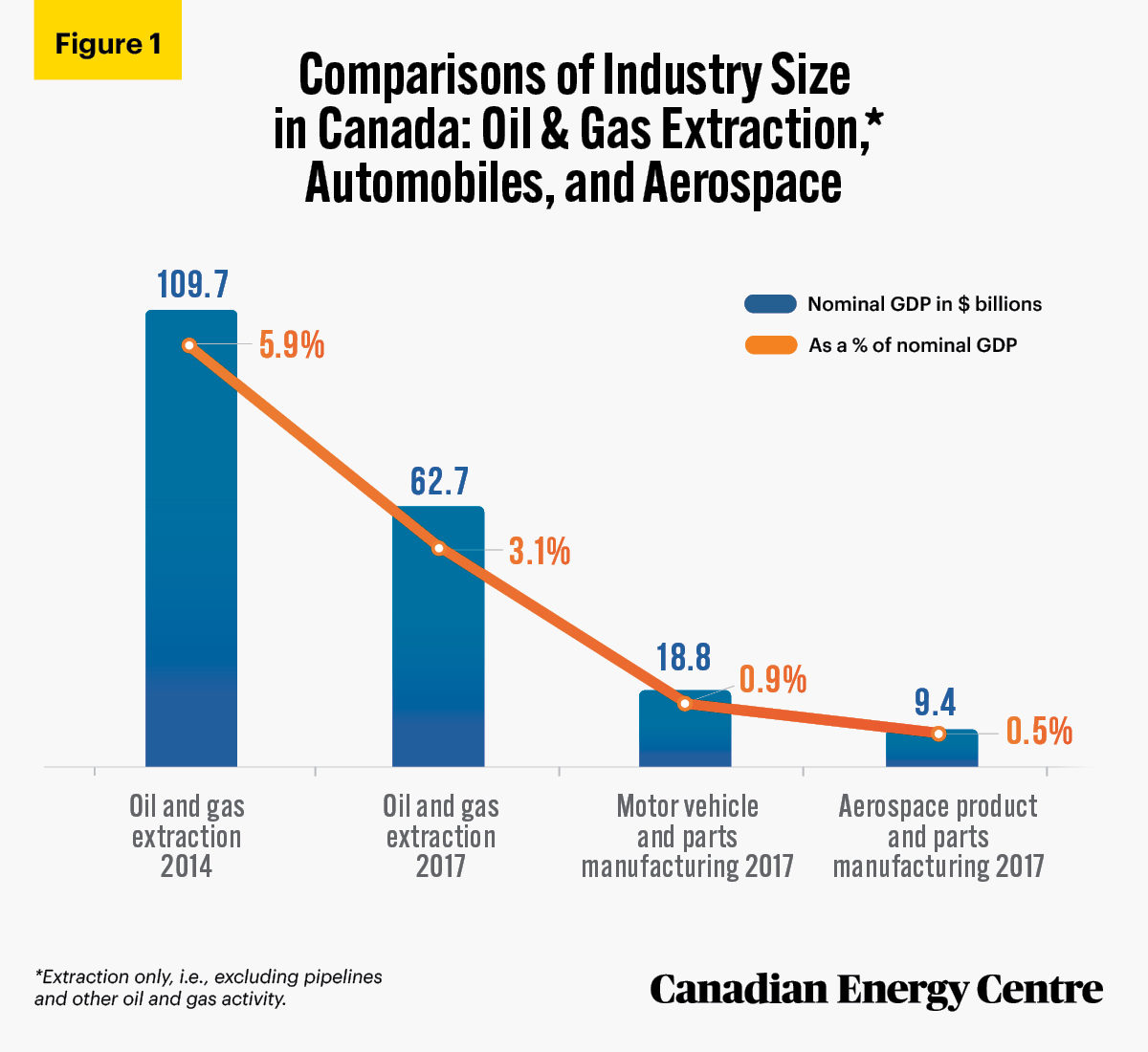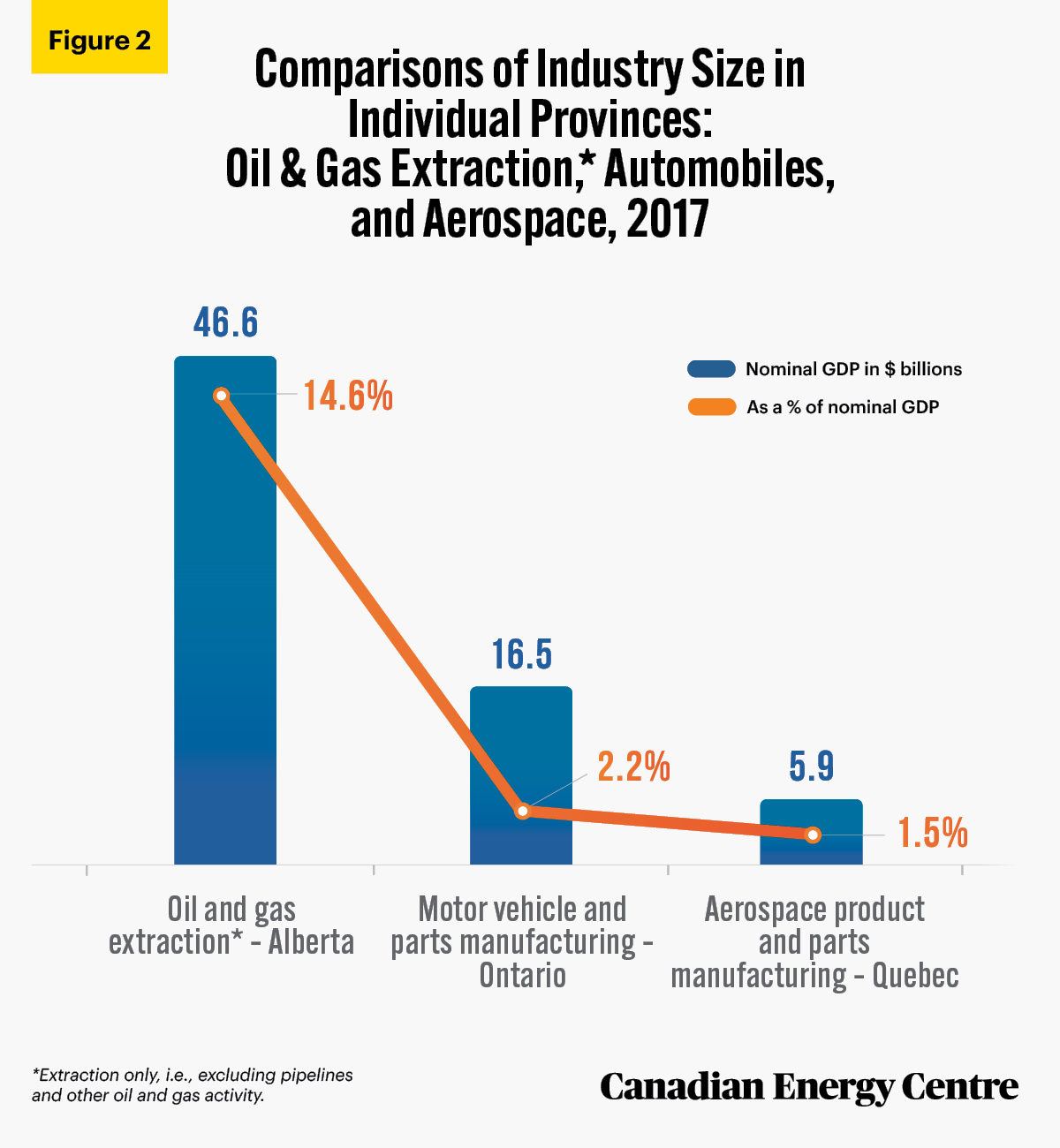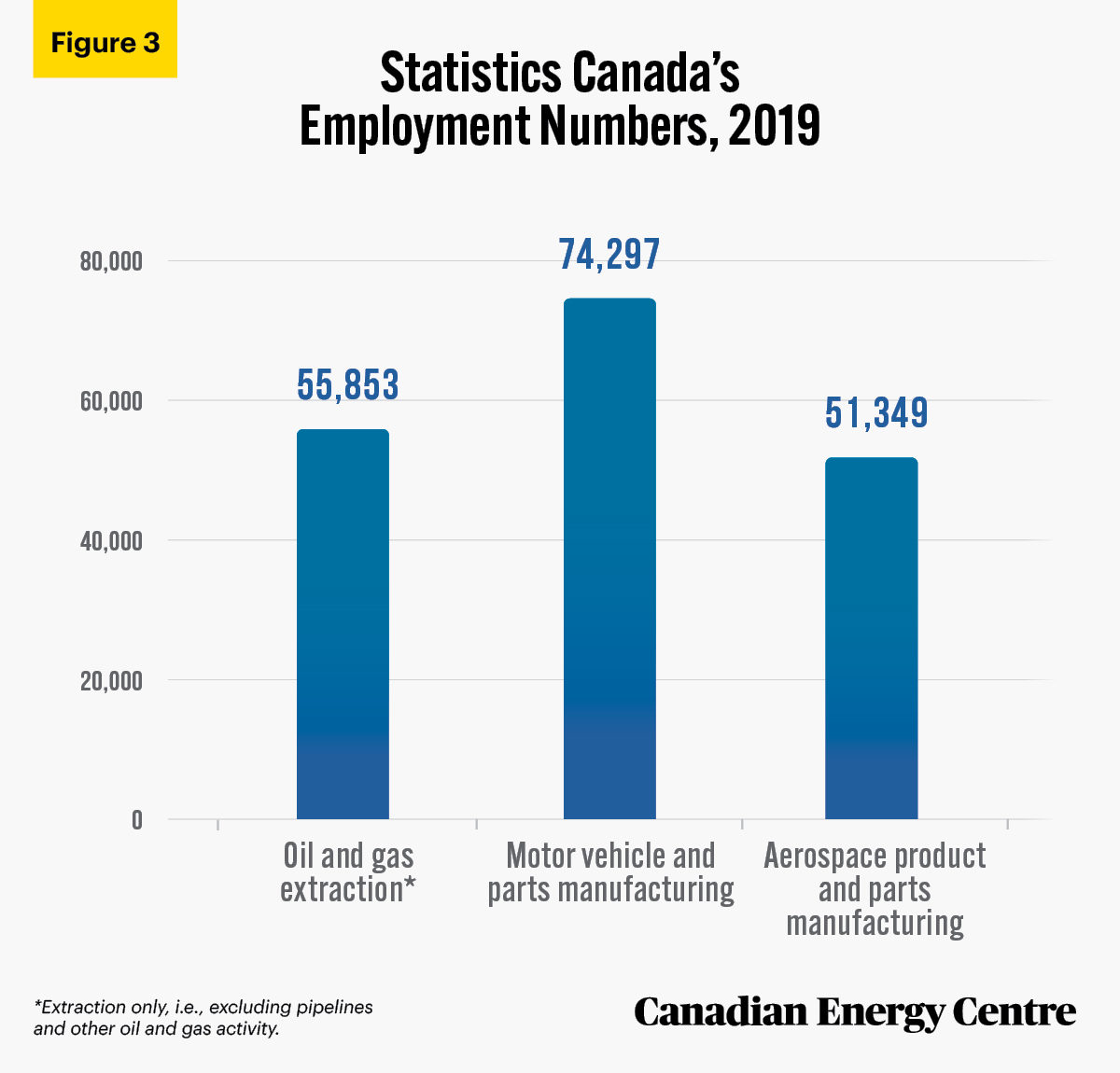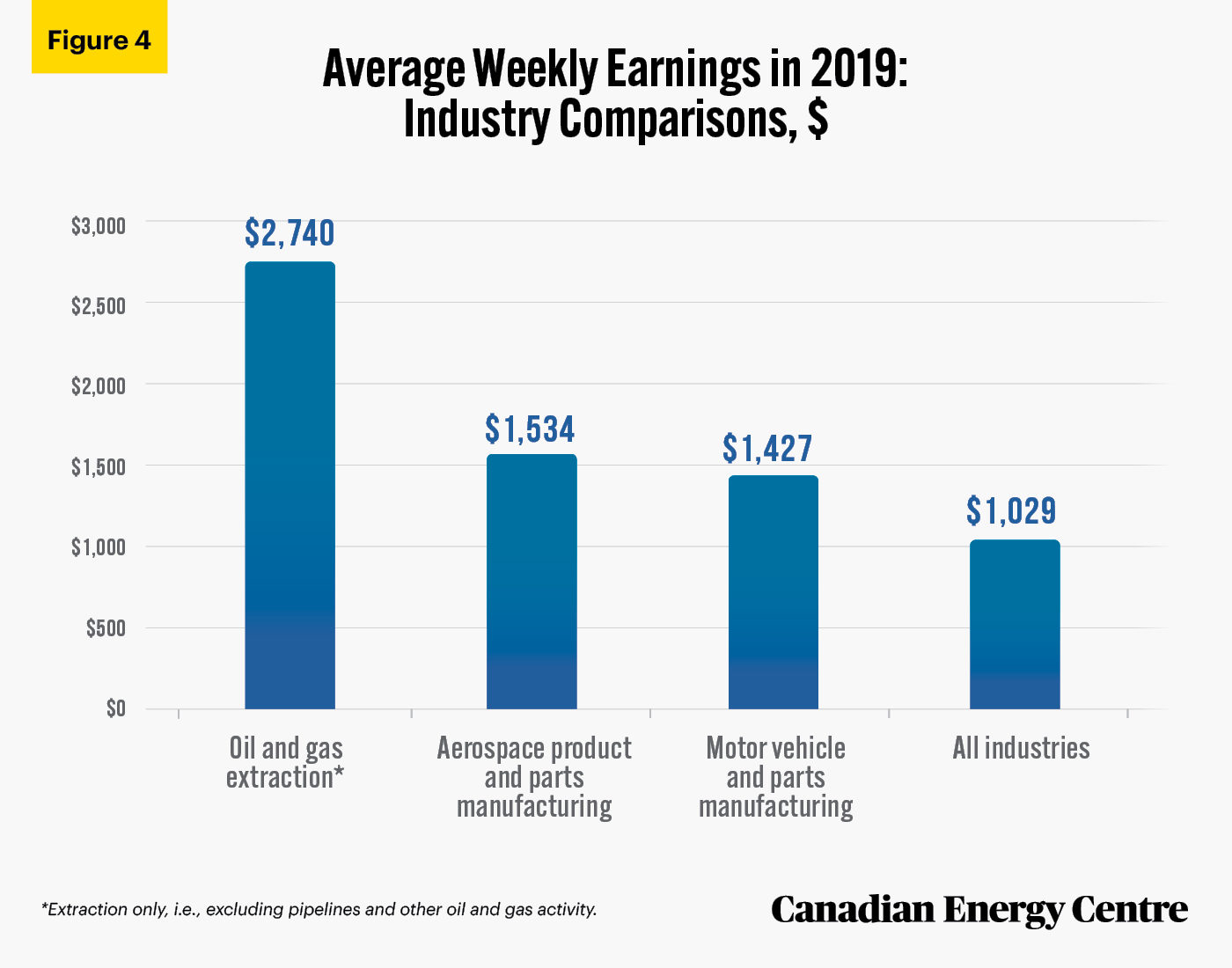To sign up to receive the latest Canadian Energy Centre research to your inbox email: research@canadianenergycentre.ca
Download the PDF here
Download the charts here
Overview
Canada’s oil and gas extraction sector remains an integral part of the Canadian economy and fares well in comparison with the automotive and aerospace sectors, despite the drop in energy prices.
This CEC Fact Sheet compares Canada’s oil and gas extraction sector (narrowly defined to include conventional oil and gas and oil sands, but not other oil and gas activity related to pipeline construction and other operations) with the automotive and aerospace sectors on national and provincial nominal GDP, employment, and wages.
Statistics Canada data enable us to provide an “apples-to-apples” comparison between oil and gas extraction in both 2014 (a peak year) and 2017 and 2019 (the latest years available) with motor vehicle and parts manufacturing, and aerospace products and parts manufacturing in those latter years.
Comparing GDP: Oil and gas extraction is over three times as large as the automotive sector and nearly seven times as large as the aerospace sector
- In 2014, the oil and gas extraction sector accounted for $109.7 billion, or 5.9 per cent of Canada’s nominal GDP. Even with the decline in the world crude oil price in the years that followed, in 2017 the oil and gas extraction sector still accounted for $62.7 billion, or 3.1 per cent of Canada’s nominal GDP (see Figure 1).
- By contrast, in 2017 the motor vehicle and parts manufacturing sector accounted for $18.8 billion, or 0.9 per cent of Canada’s nominal GDP, while the aerospace product and parts manufacturing sector accounted for $9.4 billion, or 0.5 per cent, of Canada’s nominal GDP (see Figure 1).

Source: Statistics Canada. Table 36-10-0401-01
- In a comparison of individual provinces, in 2017 the oil and gas extraction sector accounted for nearly $46.6 billion, or 14.6 per cent, of Alberta’s nominal GDP. By contrast, in that same year the motor vehicle and parts manufacturing sector accounted for $16.5 billion, or 2.2 per cent, of Ontario’s nominal GDP, while the aerospace product and parts manufacturing sector accounted for $5.9 billion, or 1.5 per cent, of Quebec’s nominal GDP (see Figure 2).
In other words, even in a “slump” year for world oil prices, in 2017, nominal GDP for Canada’s oil and gas extraction sector was three times that of the automotive sector and nearly seven times that of the aerospace sector.

Source: Statistics Canada, Table 36-10-0401-01.
Comparing employment
Labour productivity in Canada’s oil and gas extraction sector is high; the sector generates over three times the GDP of the automotive sector even though it employs nearly 25 per cent fewer people. The oil and gas extraction sector generates nearly seven times the GDP of the aerospace sector while employing about nine per cent more people.
- In 2019, the oil and gas extraction sector (i.e., excluding pipelines and other oil and gas activity) directly employed 55,853 Canadians across the country (see Figure 3).
- In contrast, in 2019, the motor vehicle parts manufacturing sector directly employed 74,297 Canadians, while the aerospace product and parts manufacturing sector directly employed 51,349 Canadians (see Figure 3).

Source: Statistics Canada, Table 14-10-0202-01.
Comparing wages: 92% to 166% higher in oil and gas
Average weekly earnings in the oil and gas extraction sector were 92 per cent higher than in the automotive sector, 79 per cent higher than in aerospace, and 166 per cent higher than the all-industry average.
Those working in the oil and gas extraction sector earn high incomes relative to other industries in Canada. In 2019, average weekly earnings by industry were:
- $1,427 in motor vehicle and parts manufacturing;
- $1,534 in aerospace product and parts manufacturing; and
- $2,740 in oil and gas extraction (see Figure 4).
The average for all industries in Canada in 2019 was $1,029 in weekly earnings. When compared with the average across industries, weekly earnings were:
- higher in motor vehicle parts manufacturing (by 39 per cent);
- higher in aerospace product and parts manufacturing (by 49 per cent); and
- significantly higher in the oil and gas extraction industry (by 166 per cent) (see Figure 4).

Source: Statistics Canada, Table 14-10-0204-01.
Conclusion
The Canadian oil and gas extraction sector continues to power the Canadian economy even in down years such as 2017 (GDP) and 2019 (employment and wages). Although energy prices have been depressed over the last few years, oil and gas extraction still compares very favourably on various economic metrics (GDP, employment and wages) to the automotive and aerospace sectors.
Notes
This CEC Fact Sheet was compiled by Lennie Kaplan and Mark Milke at the Canadian Energy Centre (www.canadianenergycentre.ca). Image credits: Oscar Bovenkerk
References (All links live as of May 7, 2021)
Statistics Canada (2021a), Table 14-10-0202-01: Employment by industry, annual <http://bit.ly/3ltepTy>; Statistics Canada (2021b), Table 14-10-0204-01: Average weekly earnings by industry, annual <http://bit.ly/3tCAjrz>; Statistics Canada (2021c), Hourly and weekly wages for employed employees by industry, North American Industry Classification System (NAICS) for Canada and selected provinces, 2-year moving average, Table, custom tabulation; Statistics Canada (2021d), Table 36-10-0401-01: Gross domestic product (GDP) at basic prices, by industry (x 1,000,000) <http://bit.ly/38e5f9Z>; Statistics Canada (2021e), Table 36-10- 0402-01: Gross domestic product (GDP) at basic prices, by industry, provinces and territories (x 1,000,000) <http://bit.ly/3vJXl1F>.
Creative Commons Copyright
Research and data from the Canadian Energy Centre (CEC) is available for public usage under creative commons copyright terms with attribution to the CEC. Attribution and specific restrictions on usage including non-commercial use only and no changes to material should follow guidelines enunciated by Creative Commons here: Attribution-NonCommercial-NoDerivs CC BY-NC-ND.
